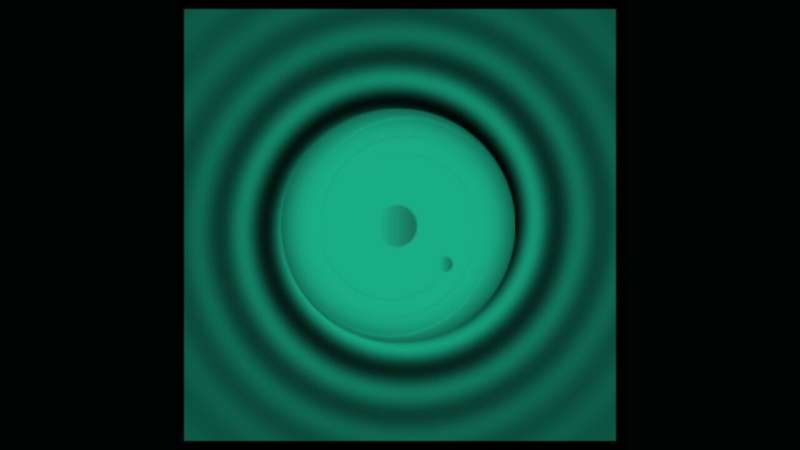
October 20, 2024 by Tejasri Gururaj , Phys.org
Collected at: https://phys.org/news/2024-10-impact-ultralight-dark-gravitational.html
A recent study in Physical Review Letters explores the effects of ultralight dark matter in extreme-mass-ratio inspirals (EMRIs), which could be detected by future space-based gravitational wave detectors like LISA (Laser Interferometer Space Antenna).
Given the numerous proposed forms of dark matter, scientists are investigating multiple approaches for their detection.
This study centers on understanding how ultralight dark matter behaves in relation to extreme mass ratio inspirals (EMRIs). These systems consist of a supermassive black hole (SMBH) in conjunction with a smaller astronomical body, which may be a star or another black hole.
The gravitational waves emitted by these systems as the smaller stellar object spirals into the SMBH could point to the behavior of ultralight dark matter in and around these systems.
Phys.org spoke to the authors of the study to gain a better understanding of their work.
Speaking of the team’s motivation behind the study, Dr. Francisco Duque, a postdoctoral researcher at the Max Planck Institute for Gravitational Physics and first author of the study, said, “Understanding the fundamental nature of dark matter is one of the major unsolved problems in modern physics.
“We know it has to exist for galaxies to form and evolve to their current state. But dark is just a fancy way of saying we have no idea what this is, except that it interacts weakly with other particles in the standard model.”
Ultralight dark matter
Ultralight dark matter consists of small-mass dark matter particles, modeled as scalar bosons, which have no intrinsic spin. This creates a scalar field, which is smoothly distributed in space, similar to how temperature is evenly distributed in a room.
This type of dark matter presents in different forms, like fuzzy dark matter and boson clouds. These particles can be up to 1028 times lighter than an electron.
Fuzzy dark matter doesn’t clump in the same way that traditional dark matter particles do. Rather, it displays significant wave-like behavior on a large scale because of the particles’ small mass. On small scales, fuzzy dark matter can influence the behavior of galactic structures.
On the other hand, boson clouds are found around rotating black holes. The boson cloud taps into the energy of the black hole and grows in size, causing energy to scatter instead of being absorbed by the black hole. This process is known as superradiance.
If either of these theorized forms of ultralight dark matter exists in EMRIs, it could alter the gravitational waves emitted by these systems.
A relativistic approach
Although earlier studies have probed the environmental effects on EMRIs, they have relied entirely on Newtonian approximations. However, in extreme gravity environments or when dealing with high speeds (close to the speed of light), relativistic effects can’t be ignored.
The research team, therefore, decided to incorporate a fully relativistic framework to study the environment around EMRIs. Their aim was to use this framework to study the energy lost in EMRIs due to gravitational waves of the inspiral and the depletion of the scalar field as it interacts with the binary system.
Dr. Rodrigo Vicente, a postdoctoral researcher at the Institute for High Energy Physics of Barcelona and co-author of the study, explained their findings: “As smaller black holes orbit around the SMBH, they move through the dark matter and create a dense trailing wake, similar to the wake created by a swimmer in a pool. This wake exerts an additional gravitational attraction on the small black hole called dynamical friction, slowing it down and altering the gravitational wave signals.”
The densities of the ultralight dark matter clouds around the SMBH can reach 20 times that of gold, highlighting the significant impact of ultralight dark matter in the evolution of EMRIs and other similar systems.
LISA and future detections
The shift in the gravitational wave signals due to ultralight dark matter could be detected on Earth by future detectors like LISA.
Dr. Caio Macedo, a professor at Universidade Federal do Pará and co-author of the study, explained, “LISA, which is expected to be launched in 2035 by the European Space Agency, will be sensitive to millihertz frequencies, allowing it to observe EMRIs with high precision. LISA will be able to track these systems for weeks, months, or even years, and is then perfectly suited to observe the phase shift introduced by dynamical friction, which accumulates over many cycles.”
However, if such effects are not seen, the data from LISA can be used to put tight constraints on the existence of ultralight fields over a wide range of masses.
Beyond dark matter
In addition to the dynamical friction effect, the researchers were also able to study how fuzzy dark matter and boson clouds act differently.
The researchers found that in the case of fuzzy dark matter around SMBHs, the energy loss due to scalar field depletion can exceed that from gravitational wave emission, especially when the smaller object is distant from the SMBH.
Incorporating a relativistic framework also uncovered resonant behavior in the gravitational waves, a relativistic effect absent in Newtonian models.
For boson clouds, they found that the energy dissipation via scalar depletion is highly sensitive to the properties of the surrounding environment.
With a more precise model of how different matter types affect gravitational waves, this study has the potential to greatly advance our understanding of gravity, presenting a vital avenue for exploring dark matter.
Speaking of future work, the researchers mention expanding their framework to account for eccentric orbits, which are more likely to be seen in EMRIs.
They also plan to adapt their relativistic framework for active galactic nuclei (AGN) disks, which are thought to house significant amounts of dark matter. With dark matter being essential to the formation of large-scale structures, this research may provide greater clarity on its role in the universe.
More information: Francisco Duque et al, Extreme-Mass-Ratio Inspirals in Ultralight Dark Matter, Physical Review Letters (2024). DOI: 10.1103/PhysRevLett.133.121404
Journal information: Physical Review Letters

Leave a Reply